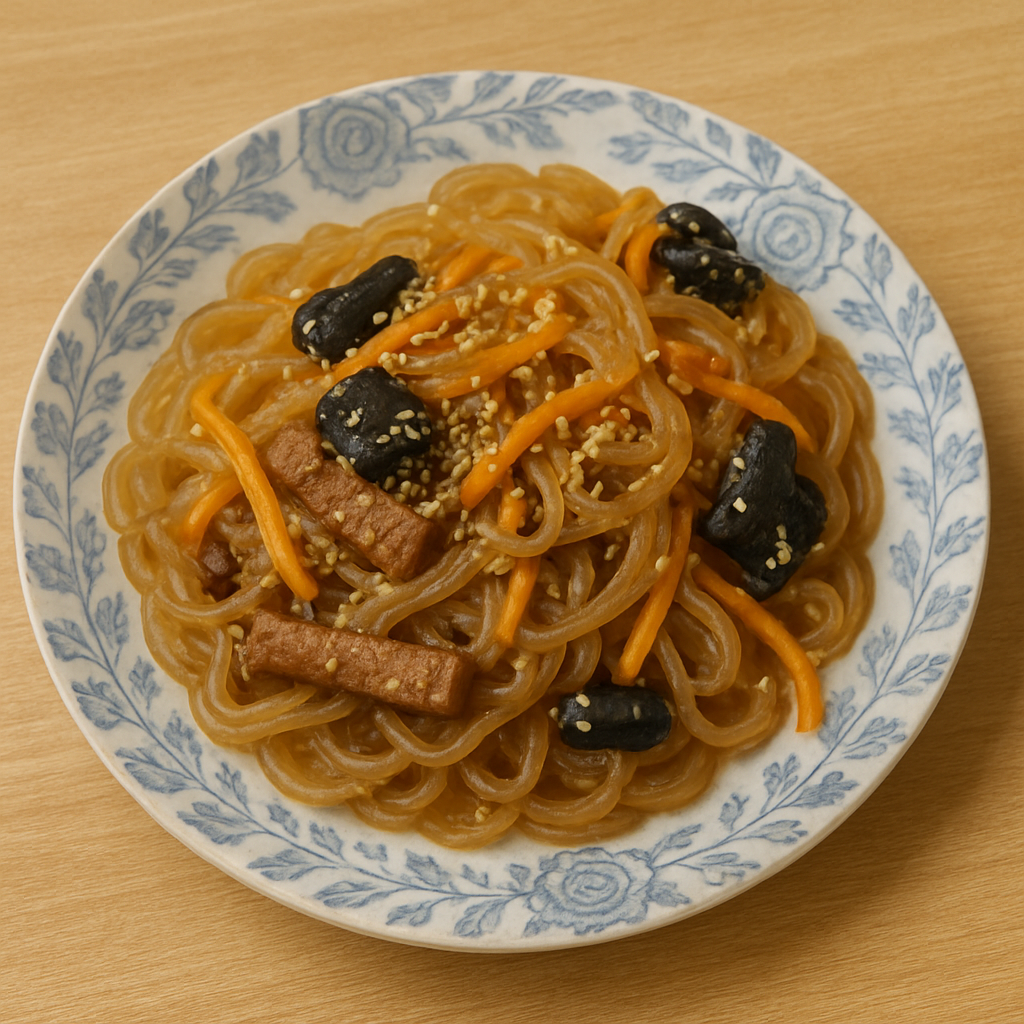A Taste of Celebration That Became an Everyday Comfort
Growing up in Korea, japchae (잡채) wasn’t an everyday meal—it was a special meal. It showed up at birthday parties, weddings, and holidays like Chuseok and Seollal, glistening on a large platter in the center of a bustling table.
My mom always made a big batch in a wide silver bowl, seasoning each ingredient one by one before tossing them all together with her hands. It was a labor of love—painstakingly sliced carrots, mushrooms soaked just right, beef marinated with garlic and soy. And in the end, those chewy glass noodles would soak up every drop of flavor.
Now, living abroad, I no longer wait for a holiday. When I miss home—or need something grounding—I make japchae. Over time, I’ve come up with a version that’s simple, comforting, and fits right into my everyday kitchen abroad. It’s not loaded with every veggie under the sun, but it has the essentials: soft glass noodles, stir-fried beef, earthy wood ear mushrooms, sweet carrots, and a touch of toasted sesame. Sometimes, that’s all you need.
What Is Japchae?
Japchae literally means “mixed vegetables,” but it’s better described as a glass noodle stir-fry packed with sweet and savory flavors. Traditionally made with dangmyeon (당면), Korean sweet potato starch noodles, it’s tossed with various vegetables, thinly sliced beef, and a soy-sesame sauce.
Despite its fancy reputation, it’s surprisingly easy to make at home—and endlessly customizable.

🛒 Ingredients You’ll Need
For the Noodles:
- 200g Korean glass noodles (dangmyeon)
For the Protein:
- 150g beef, thinly sliced (ribeye or sirloin recommended)
- 1 tbsp soy sauce
- 1 tsp sugar
- 1 tsp sesame oil
- 1 clove garlic, minced
For the Vegetables:
- 1 cup carrot, julienned
- 1 cup onion, thinly sliced
- 1 cup wood ear mushrooms, soaked and sliced
- 1 tbsp neutral oil for stir-frying
For the Sauce:
- 4 tbsp soy sauce
- 2 tbsp sugar
- 2 tbsp sesame oil
- 1 tbsp mirin or rice wine (optional)
- 1 tsp minced garlic
- Pinch of black pepper
Garnish:
- 1 tbsp toasted sesame seeds
- Thinly sliced green onion (optional)
Note: In the version I’m sharing here—just like in the photo I took—there’s no spinach, bell pepper, or shiitake mushrooms. But those are popular additions in many households, and if you’d like to include them, go for it!
🌍 Ingredient Accessibility & Substitutes
Is japchae easy to make outside Korea? Absolutely. Here’s how to shop smart:
🍜 Dangmyeon (Korean Glass Noodles)
- Where to buy: Korean or Asian grocery stores, Amazon, H Mart, or online Korean food markets
- Label keywords: “Sweet potato starch noodles” or “glass noodles”
- Substitute: Chinese mung bean glass noodles can be used in a pinch, though they’re less chewy
🍄 Wood Ear Mushrooms
- Where to buy: Dried versions are common at Asian markets, Amazon, or international aisles at Whole Foods
- How to prep: Soak in warm water for 15–20 minutes before slicing
- Substitute: Regular mushrooms (like oyster or crimini) work too—flavor will differ but still good
🍶 Mirin or Korean Cooking Wine
- Where to buy: Found in most Asian grocery stores or online
- Substitute: Dry white wine + a pinch of sugar, or just skip it—it adds complexity but isn’t essential
🥩 Thinly Sliced Beef
- Tip: If you can’t find pre-sliced meat, buy ribeye or sirloin and slice thinly yourself (freeze it for 30 minutes first—it’s easier that way)
👩🍳 How to Make Japchae
1. Soak & Boil the Noodles
- Cook dangmyeon noodles in boiling water for 6–7 minutes
- Rinse in cold water and drain well
- Toss with a bit of sesame oil to prevent sticking
2. Marinate the Beef
- Combine beef with soy sauce, sugar, sesame oil, and garlic
- Let it marinate while you prep the veggies
3. Prep the Vegetables
- Julienne the carrots and slice the onion
- Soak wood ear mushrooms, then slice thinly
- Stir-fry each vegetable individually over medium heat with a bit of oil and a pinch of salt
- Set everything aside
4. Cook the Beef
- Stir-fry the marinated beef in a pan until cooked through
5. Mix the Sauce
- In a small bowl, stir together soy sauce, sugar, sesame oil, mirin (if using), garlic, and black pepper
6. Combine Everything
- In a large mixing bowl or pan, combine noodles, beef, and all vegetables
- Pour in the sauce and toss thoroughly to coat
- You can warm everything together in a pan briefly if serving hot
7. Garnish & Serve
- Sprinkle with toasted sesame seeds
- Top with green onion if you like
🍽 Serving Tips
- Serve warm, at room temperature, or even cold—japchae is delicious at any temperature
- Great as a main dish or as part of a Korean table with side dishes (banchan)
- Leftovers? Reheat gently or enjoy as-is the next day—it keeps well for 2–3 days
💭 What Japchae Means to Me
When I make japchae in my kitchen today, I hear the echo of my mom’s voice: “Taste it again—maybe just a little more soy sauce?”
It reminds me of folding tables full of cousins, paper plates, and a big silver bowl of noodles at the center, everyone sneaking bites before the meal “officially” started.
This version isn’t elaborate. There’s no spinach or fancy mushrooms. Just the ingredients I love, and the flavor I grew up with. Comforting, slightly sweet, deeply savory—just like home.
📌 Final Thoughts
Japchae doesn’t need a holiday—it makes an ordinary day feel special.
Whether you’re Korean and nostalgic like me, or just discovering the joy of Korean cooking, I hope this recipe brings warmth to your table.
Have you tried japchae before? Share your version in the comments below—or tag me on Instagram! I’d love to see your take 💬


Leave a Reply